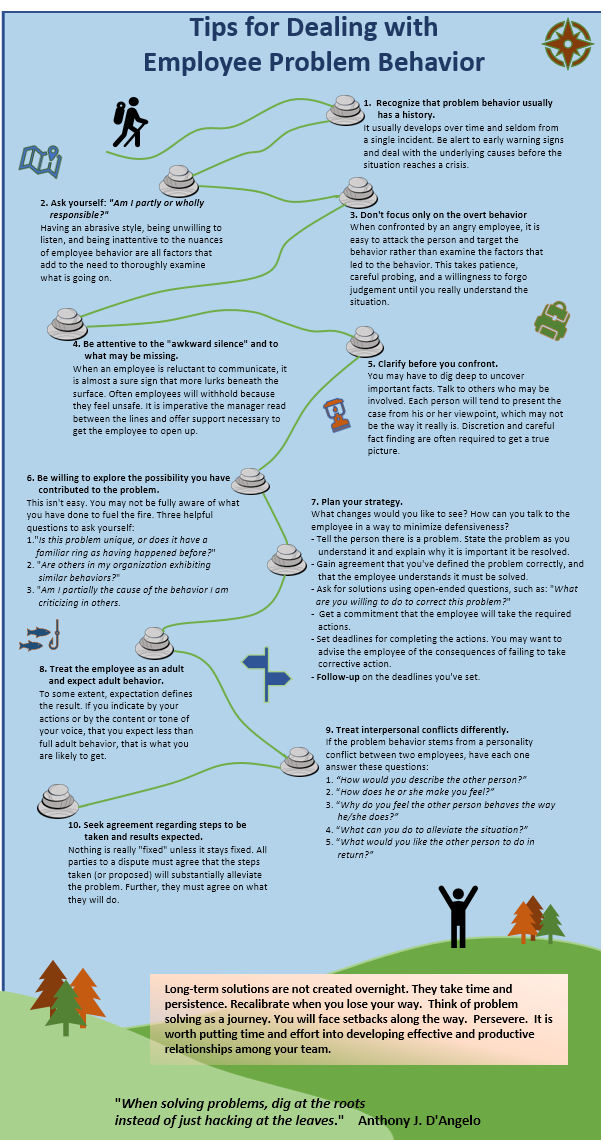Supervisory Tools
Sharpen your supervisory/managerial skills!
![]()
Impaired Performance
Work Problem Check List
Handling Conflict
Creative Problem Solving
Design Thinking, lynda.com.
Making Meetings Meaningful
Meeting Villains
Business Meeting Etiquette Rules
11 Things Leaders Need To Talk About When They Meet With Their Staff, by Patty Azzarello. February 25, 2016. TLNT.
Managing Projects
Ted Talk: Yves Morieux: As work gets more complex, 6 rules to simplify. See #6.
Smart Simplicity Framework, LinkedIn Slideshare.
Dartmouth College Training and Professional Development
Project Management's Bottom Line, lynda.com.
Human Resources Manager's Toolkit
Managing Your Time
12 Principles Behind the Agile Manifesto, The Art of Doing Twice as Much in Half the Time: Jeff Sutherland, TED Talk
Time Management courses on Lynda.com
How to be a Great Supervisor
Concerned About Being Biased?
Helping Your Grieving Employee
Identifying a Bully
The Basics of Coaching for Your Employees
Steps in Coaching
Coaching is a form of employee training and development, whether it's on-the-job or off, planned or impromptu. The science of employee training and development can't easily be reduced to a bullet list of steps to follow, and you may notice some glaring omissions from the list below. With that disclaimer in mind, here's a list of a few steps for managers to use when coaching their employees.
- Put the employee at ease. This step is important when the coaching session is a response to poor performance - it's not as important in other situations.
- Find out what they already know. There are two reasons for this. First, there's little use in telling them what they already know. Second, prior knowledge serves as the foundation for new knowledge that's acquired. Hence, you want to link the "training" to what they already know and correct any misconceptions that could interfere with their learning.
- Present information or demonstrate work methods. This is the point where you deliver the content of the training.
- Repeat. Repetition enhances understanding and retention.
- Evaluate learning. Test whether the employee understands the information or can perform the skill.
- Provide feedback. Let the employee know what they have successfully learned and what they still need to learn.
- Correct. Show the right answers or methods again.
- Evaluate performance on the job. Periodically check to see whether the employee is using the knowledge or skills effectively on the job. Gradually increase the interval at which you check. The employee should eventually take responsibility for monitoring their own performance.
- Reward. Provide praise or other rewards for successful acquisition and use of the knowledge or skill.
Dealing with Problem Behavior
Expressing clear goals and expectations, together with encouraging and practicing open communication, can proactively avert many problems. Try to establish balanced and insightful policies and practices before small problems become persistent and more complicated. When problem behavior does arise there are effective steps to take.

As a supervisor, you are in a unique position to motivate employees to seek assistance for their problems. It can be difficult to tell an employee that his/her performance is below standard and must change. It is also unusually difficult for employees to accept that personal problems are affecting their job performance. Frequently, employees who have persistent performance or attendance problems are found to have underlying difficulties which are causing problems on the job. The supervisor can provide motivation toward health and productivity by addressing the poor performance and simultaneously offering a source of professional help.
When Should I Contact FEAP?
In the position of supervisor or manager, you may become aware of several situations in which it would be beneficial to contact F/EAP such as:
- When an employee demonstrates a change in work performance. This change may be sudden or develop over a period of time and may include one or more of the following:
- Absenteeism, attendance problems
- Declining or inconsistent work performance
- "On-The-Job" absenteeism
- Frequent tardiness
- Increased errors, accidents, missed deadlines
- Difficulties with concentration, confusion
- Change in attitude, mood, appearance
- Change in work relationships
- Frequent complaints
- When there are no work performance problems but an employee shares a personal problem with you.
- When you are feeling stressed, frustrated, helpless, disappointed or anxious when thinking about an employee's work performance problems.
How Do I Make a Referral?
A persistent performance problem is unlikely to resolve without any supervisory intervention. When referring an employee to F/EAP, use the following steps:
- Document the employee’s performance. Your HR Consultant can offer assistance in following proper disciplinary procedures.
- Contact F/EAP at 844.216.8308 and ask to be connected with the on-campus F/EAP counselor.
- Talk with employee about job performance expectations and outline what changes are needed.
- Recommend F/EAP as a resource to help resolve problems. The earlier an employee seeks help, the more easily problems can be resolved.
- Focus on work performance issues. Do not try to diagnose personal problems.
- Schedule a follow-up meeting to evaluate the employee's progress in reaching job performance standards.
What if an Employee Refuses to Use F/EAP?
An employee's involvement with F/EAP is voluntary. Whether an employee chooses to use F/EAP or not, the supervisor needs to continue to monitor job performance. An employee is not sheltered from disciplinary procedure by participation in F/EAP. Nor can an employee be disciplined for not seeking assistance. Whether the F/EAP is utilized or not, the employee is still responsible for his or her work performance.
